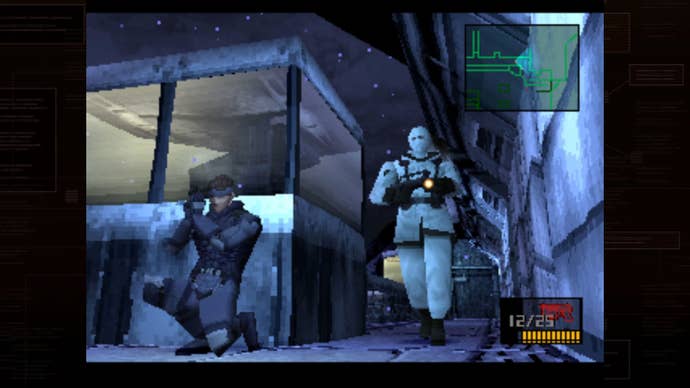Metal Gear Solid Master Collection (Vol 1) review: A soft collection of solid games
A serviceable, if incomplete, collection that's still the best legitimate modern way to play these classic Metal Gear Solid games
The first thing I do when I gain access to the medical menu in MGS3 as part of the new Metal Gear Solid Master Collection (Vol 1) is shake the right stick to whip Naked Snake around like a ragdoll.
Satisfied, I back out into the game as Snake falls to his knees and blows chunks on the jungle floor.
A smile spreads across my face. Everything is as it should be.
Whether it’s slipping on bird poo, lectures about the dangers of cigarettes or playing with the system clock until a boss dies of old age, when it comes down to it, the Metal Gear Solid series isn’t legendary just for its labyrinthine plot and kooky characters, but its dedication to being constantly surprising, playful and, above all, reactive.
Particularly in MGS3, the amount of unique, reactive mechanics is still staggering. From burning off leeches with a cigar after you’ve taken a dip in a river to blending into the environment with a distinct array of different camouflages, the Metal Gear games feel bespoke in a way that a lot of modern games don’t.
That makes it a funny old series to remaster. By their nature, the Metal Gear games were designed to be fresh, exciting and innovative. But while they’ll never recapture that quite same essence again, the Metal Gear Solid Master Collection (Vol 1) includes the best expressions of these classic games that you can buy new.

Included with the Metal Gear Solid Master Collection (Vol 1) are two proto-Metal Gear NES games from the late ‘80s and early ‘90s, the original and previously Japan-only “Integral'' versions of MGS1, and ports of the HD remasters of MGS2 and MGS3 that came out at the start of the 2010s. Plus, you also get the couple of digital graphic novels that originally came out on the PSP in Japanese.
It’s really important that you don’t go into these games expecting any major revamps outside of what was already done in the HD remaster. The only updated controls are things like pressing the touch pad instead of the now-defunct select button for Codec calls, and really the only stuff you won’t have already seen as a long-time fan is the Integral version of MGS1 and the “Master Books” for every title in the series.
It’s good, then, that the Master Books are fantastic. They’re well-produced, nostalgically strategy guide-style digital magazines which brilliantly detail the background to each game, summarise its story and clearly spell out its connections to the wider narrative, going through character arcs, geopolitical inspirations and more, with a healthy dose of Yoji Shinkawa’s iconic artwork throughout.

However, the Rex in the room is that this isn’t even the most complete collection Konami has put out in the last 10 years. Metal Gear Solid: The Legacy Collection included pretty much all of this stuff (bar the Master Books, of course) on the PS3 in 2013, along with MGS4 and the PSP’s incredible MGS: Peace Walker.
To have such a great celebration of the series as the Master Books draw heavily on story beats from these two canonically important games and then have them not be present in the collection is disappointing and speaks to the extra effort it’s probably taking to port over the notoriously difficult to emulate MGS4. But to have the core trilogy removed from sale then come back with relatively little to show for it isn’t very impressive.
A tiny detail which shows that this is a patchwork of previous remasters rather than one cohesive collection is that MGS1 still has the original backwards buttons (Circle to select, X to return), while the HD remasters of MGS2 and MGS3 don’t. And there are other minor inconsistencies in features, like MGS1 has a suspend menu when you bounce to the console home screen, while the latter games don’t either.
It also seems like the opportunity was missed to add modern Quality of Life features like pausable cutscenes. Literally who wants to press start once to skip everything (other than speedrunners)?

But despite the collection not living up to previous iterations, there’s still the interesting conundrum of how the games have aged, another decade down the road from their original release.
As you’d expect, the first Metal Gear Solid fares the worst from this light touch update, even if the inclusion of the Integral content is one of only reasons to pick this collection over previous ones. Because it’s a PS1 game, MGS1’s aspect ratio is wrong for modern TVs, so you’re always playing with a boarder, the input lag makes it makes it feel like you’re in reverse bullet time, and the textures make every character look like the bit where Neo’s mouth goes all gluey in The Matrix.
However, the impressive direction is plain to see. From the camera angles to the atmospheric details, this is the game that’s held up most by nostalgia, but you’re left with no illusions as to why we loved this in the first place.
Then, because they’ve already had the HD treatment, MGS2 and MGS3 feel much cleaner – even if firing a gun still feels like solving a Rubik's cube. They’re similarly stiff, obviously; particularly if you have a memory of playing the 3DS version of Snake Eater where you could crouch walk. But like I said, the unique mechanics and reactive environments still absolutely shine.
Having the entire main Metal Gear storyline in one package as has previously been released would have been fantastic, but as it stands, this Metal Gear Solid Master Collection (Vol 1) is the best legitimate way to play these classic games.
The Master Books are bursting with interesting tidbits that helped me to contextualise each game and the storyline as a whole better than ever before, but there’s relatively little within the games themselves to make this a real must-have if you still have access to previous collections and releases.
The Metal Gear Solid: Master Collection Volume 1 is out October 24, on PC, Xbox Series X/S, PS5, and Nintendo Switch.
This review was for the PS5 version of the game, with a code provided by the publisher.

